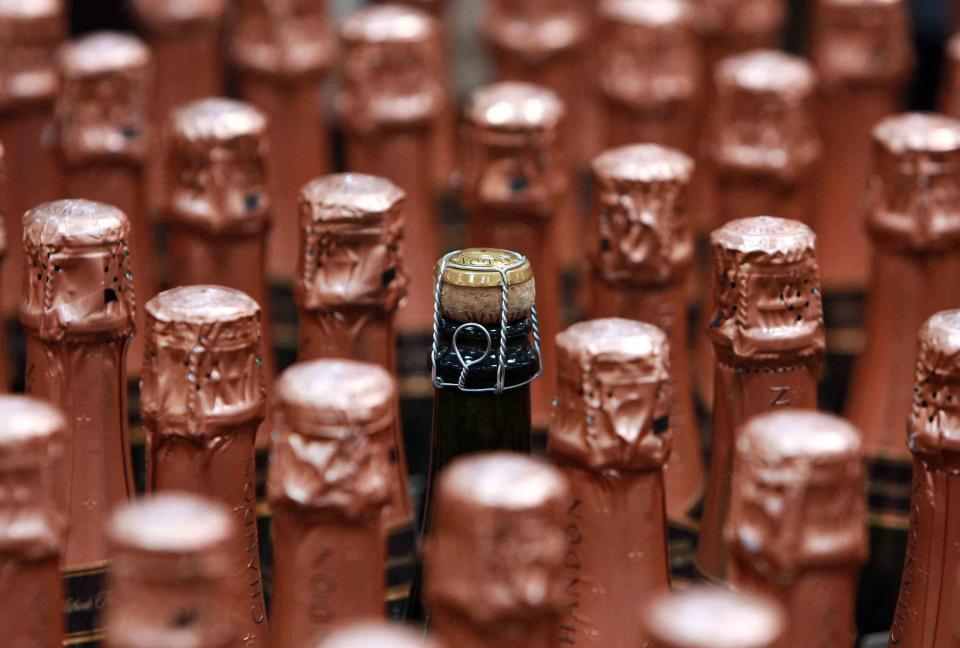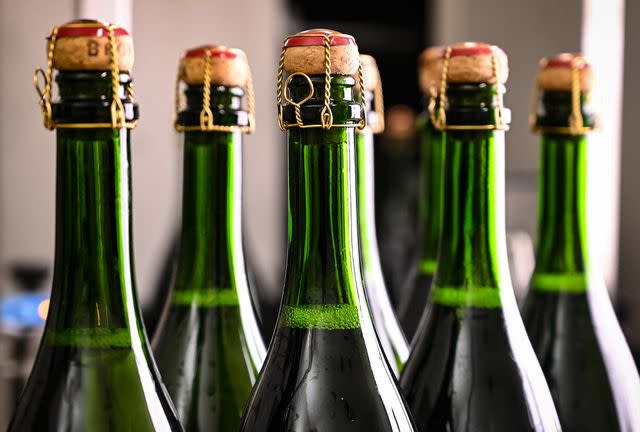How to Properly Open a Champagne Bottle, According to Champagne Experts
The only thing standing behind you and an opened bottle of Champagne is a cork and a cage.

Justin Sullivan / Getty Images
The recognizable pop of a Champagne cork is the auditory equivalent of "Let’s get this party started." Popping open a bottle of bubbly fills the room with lively effervescence before the liquid even meets lips.
But sommeliers will be the first to tell you that a surprisingly loud explosion is exactly what you don’t want when opening a bottle of Champagne. If handled incorrectly, opening a bottle of sparkling wine can cause a fussy, fizzy, not-so-festive mess.
Related: Ray Isle's Greatest Wine Tips (and Some Shenanigans, Too)
The soft and satisfying pfft sound from a bottle is a tell-tale sign that a pro is doing the opening. But you don’t have to be a sommelier to look like one. We consulted with various Champagne experts to help guide us on how to open a bottle with minimal noise, mess, and attention.
Step 1: Chill the bottle
Enjoying the perfect bottle of Champagne starts hours before. Start by chilling the bottle in the fridge for at least two hours, or in a bucket of ice (try half ice, half water) for an hour.
Aim to serve Champagne between 46°F and 50°F. Mathieu Roland-Billecart, CEO and 7th generation family member of Champagne Billecart-Salmon, prefers to chill the bottle and pull it from the fridge 20 to 30 minutes before tasting to allow it to fall to the optimal serving temperature.
“Though that also depends on the temperature outside,” he says. A hot day? Keep the bottle near ice. Chilly out? The atmosphere will help retain frosty temperatures.
"If a bottle isn’t properly chilled, you risk losing a third of your bubbles to detonation."
If a bottle isn’t properly chilled, you risk losing a third of your bubbles to detonation.
“If a bottle isn't below a certain temperature, the CO2 particles inside become more active and eager to escape,” says Todd Johnston, beverage director and sommelier of Marsh House in Nashville, Tennessee. “This can lead to explosions and flying corks.”
When taking the bottle from the fridge or out of the ice bucket, try to avoid shaking it or moving it around too much. That can similarly agitate bubbles.
Step 2: Prep the bottle
When the wine hits its ideal serving temperature, slowly remove the foil and loosen the cage around the top of the bottle.
“I start by removing the foil before presenting the bottle to my guests,” says Johnston. “With my thumb on top of the cap, I pull the wire tab down with six half turns counterclockwise, then loosen the bottom of the cage with the same hand.”
But don’t fully remove the cage yet — it will act as a safeguard in case the cork pops off unexpectedly.
"Keep the top pointed well away from faces, friends, or other things you wouldn’t like to break. An erupting cork can travel at a speed of 50 miles per hour. It can do some serious damage. For extra precautions, drape a towel over the top to aid with accidental projectiles."
“I consider it the most effective and safest way to open a bottle of sparkling wine,” says Brian Heath, CEO and owner of Heath Family Brands, a sparkling wine producer in Texas Hill Country. “Hold the bottle and the cork with one hand and loosen the cage.”
Keep the top pointed well away from faces, friends, or other things you wouldn’t like to break. An erupting cork can travel at a speed of 50 miles per hour. It can do some serious damage. For extra precautions, drape a towel over the top to aid with accidental projectiles.
Step 3: The pop
For the next step, “Hold the cork firmly in one hand and then twist the bottom of the bottle. This will make it easier to open the bottle and give you better control to release the cork slowly with less noise,” says Roland-Billecart. “For older vintages, this will enable a slower rotation and protect the cork from breaking.”
"“As the cork is removed, tilt it slightly so you hear just a ‘kiss’ releasing the pressure.” — Brian Heath, CEO and owner, Heath Family Brands"
Johnston also starts by placing his palm on the cage and cork and turning the bottom of the bottle until the cork starts to feel loose.
“I let the cork ease out under my control, allowing the pressure and gas to release quietly without a pop,” he says. “You do need to apply a bit of force and control so the pressure from the cork doesn’t overpower you.”

BERTRAND GUAY / AFP / Getty Images
If you’re doing it right, it should make a demure pfft sound. “As the cork is removed, tilt it slightly so you hear just a ‘kiss’ releasing the pressure,” says Heath.
What if the sparkling wine is under a crown cap? “Opening a crown cap can be as simple as opening a beer bottle, but it requires a bit more caution,” says Johnston. “Some un-disgorged natural wines tend to overflow, so it's wise to have a napkin and a glass ready for pouring.”
It’s worth noting that that these pro tips don’t call for shaking, spraying the bottle, or sabering.
“Traditionally, avoiding a loud pop is preferred to prevent startling or distracting guests from the dining experience,” says Johnson. “Here in Nashville, bachelorette groups often enjoy the excitement and attention that comes with a loud cork pop.”
If you're a major league ball player taking home a trophy? Someone christening a yacht? Spray to your heart's desire.
Step 4: Pouring to the top
Once the cork has been removed, hold the bottle at an angle (aim for 45 degrees) for a couple of moments to give the wine a few seconds to settle.
Then reach for the glass and hold it at a similar angle. “For pouring, it is always important to incline the glass and pour the wine down the side of the glass,” explains Roland-Billecart. “This helps to preserve the bubbles.”

ShotShare / Getty Images
Johnson argues that leaving the glass on the table is not a dealbreaker. “I never pick up a glass off the table to pour wine, despite what some service professionals might recommend. The key is a slow, steady stream.” He recommends cracking a few bottles at home to perfect the pour.
The last step is easy: Enjoy!
For more Food & Wine news, make sure to sign up for our newsletter!
Read the original article on Food & Wine.

